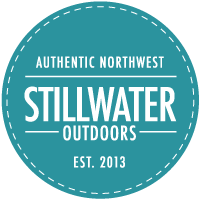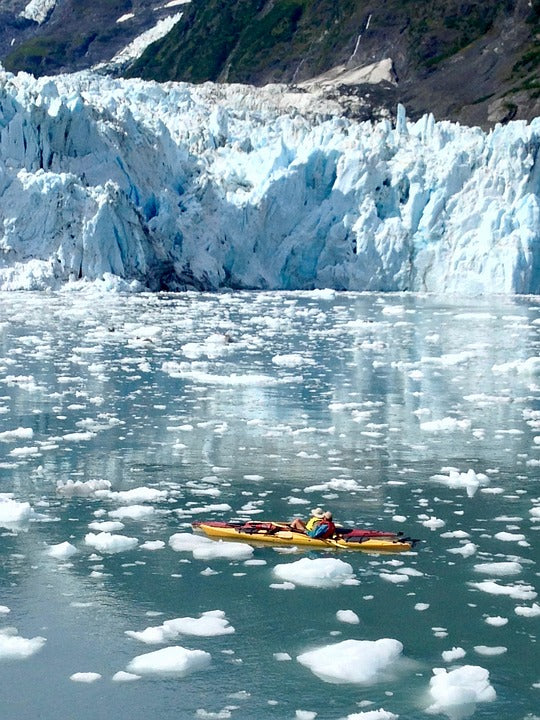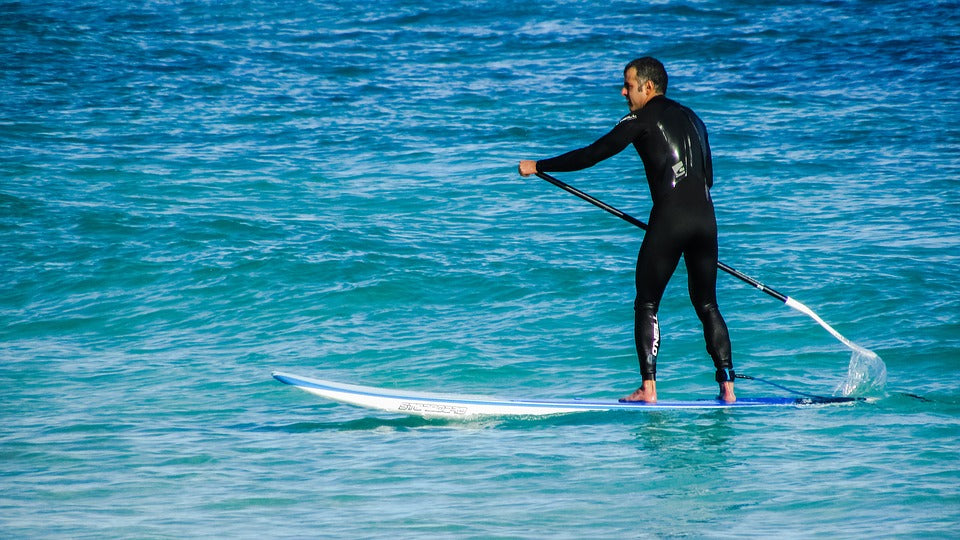Summer is ending, fall is fast approaching, and temperatures are already starting to drop ... but don't think that means you have to pack your SUP away for good. Winter brings unique opportunities to the sport.
As well as some serious dangers. Never underestimate the cold. If you plan ahead, prepare, and respect Mother Nature, there is no reason why you can't go and see a world very few have had the pleasure of witnessing ... a winter wonderland seen from the water.

1. Know the Water Temperature
We all know that SUPing is swimming, and though few of us plan to end up in the water, it happens. What most don't realize is that water doesn't have to be that cold to be dangerous. 50 degree (F) water is a lot colder and more deadly than 50 degree air. Water temperatures between 70 and 60 degrees are considered dangerous. Water temperatures below 60 degrees are considered very dangerous/immediately life-threatening. At 60 and below, you may experience total loss of breathing control, inability to control gasping, and hyperventilation. For more information on the dangers of cold water, check out the National Center for Cold Water Safety at www.coldwatersafety.org
If the water temperature is cold, it doesn't mean you can't SUP. It does mean that you should take extra precautions to ensure that you can get out of the water quickly and safely if you do fall in.
2. Watch the Weather
This is important any time you go out on an adventure as no one likes to be caught in torrential rains or unusually blistering heat. In the winter, however, the danger ramps up. That slight breeze that cooled you during the summer months now adds a wind-chill factor that could put already cold temperatures below freezing. And, honestly, who wants to set out on their adventure during a blizzard? Check the weather days in advance. Keep checking it as your target date approaches. And if there are any risks, don't go. Try again at a later, safer, time.

3. Make a Float Plan
We mentioned this in our post about general water safety/SUP safety. Make a detailed plan of your trip - where you will put in, where you will paddle, any potential "safe" areas where you may shore up in case of trouble, when you will leave, when you will return, who is going with you, what you will be wearing, and so on. Seems like a lot, but getting stranded in the winter is far more dangerous than getting stranded in the summer. Daylight temperatures in the winter months are cold enough, but when that sun goes down and the temperatures plummet, you don't want to be stranded outside. Make a plan, give it to someone you trust, and stick to it.
And when choosing your route, consider this: Can you swim to shore? If not, you should probably choose a different route. Hug shorelines and stick to shallows whenever possible to reduce the risk of drowning and/or hypothermia if you end up in the water.
4. Never Paddle Alone
In the summer, it can be tempting to venture out on your own because there is less risk. Conditions are ideal and dangers are minimal. In the winter, however, having someone with may save your life. The cold makes everything difficult and fine motor skills quickly disappear with gross motor skills following soon after. Having someone there to help in case of an emergency is vital, so never go out alone.

5. Make an Emergency Kit
Whether you plan to be out for an hour or all day, it's a good idea to have a winter-specific emergency kit with you while paddling. In it, include things you might need if you do end up stranded overnight in the cold. Matches/a lighter, water, a blanket (to save space consider placing it in a bag that can be compressed and sealed to remove air), chemical heating packets for hands and feet, flashlight, etc. If you do have to go to shore and can't make it back to your car before nightfall, you're going to need a way to stay warm. Pack with that in mind. Consider a safety beacon or flare as well, just in case.
6. Leash and PDF
In the summer months, it is tempting to SUP without actually wearing your PDF. On calm, warm water, there is less of a risk of drowning, especially for those who are strong swimmers. In cold water, however, swimming skill isn't enough to save you. Wear your PDF at all times. If you fall into cold water, the shock of it may make it difficult or impossible to swim. Always keep a leash attached as well. When the water is cold and swimming is difficult, you don't want your SUP to get out of your reach.
7. Dry Suit or Wet Suit?
Both can be used, though they work in very different ways and are more useful in different situations. A wet suit works as you might think - it absorbs water and holds it against your body, allowing your body heat to warm it. This warm water then becomes an insulating layer between you and the rest of the water. A dry suit keeps you dry by repelling the water completely and uses the air trapped near your body to keep you warm. In winter weather, particularly, a dry suit may prove more comfortable. No matter which you use, keep in mind that layers both under and over can provide extra comfort and safety. Also make sure that your clothing doesn't restrict your movements, both on the board and if you happen to fall in the water.

8. Consider Clothing Carefully
Cotton is a no-no. Why? It absorbs and holds water. Instead, use layers that hold heat, not water, like fleece and/or wool. Dress in layers as well. Lightweight layers first, then warming layers (like fleece and wool) and waterproof/repellent layers last. Hats are important, so make sure to have one. While in the cold, it's important to keep your hands and feet warm as well, so invest in good gear. Waterproof boots are nice, though they can be awkward in the water. Wet suit booties are a great alternative, though they mean your feet will be wet the entire time. Wear gloves that are waterproof and warm or consider neoprene (wet suit) options.
Two things to keep in mind when dressing for winter paddling:
Dress for the water temperature, not the air temperature
Layer properly for adjusting temperatures throughout the day (so you can remove layers when sweating and add them again when it cools)
8. Extra Gear to Consider
A dry bag is a great investment for any water enthusiast. Consider one, or two, for your winter paddling adventure. One can carry your emergency gear as well as your float plan while the second can be used to store any layers you shed or extra clothing you bring along. This will ensure they remain dry and ready to be reused later. A thermos of something hot to drink is always a great idea. Bring two, one to drink on your way out to the paddle spot and one for after you are finished for the day. That added heat after a day of cold-weather paddling will definitely be appreciated. Also consider a change of clothing. After you return to your car, changing out of anything wet will help raise your body temperature faster and will make the trip home far more comfortable.

Winter offers just as much beauty and fun as summer, as long as you don't underestimate the dangers. Here at Stillwater Outdoors, we want to encourage you to try something new, something adventurous, while remaining as safe as possible. Preparation and prevention are key, so the next time you venture out, please take an extra moment to review this guide and, as always, stay safe.







